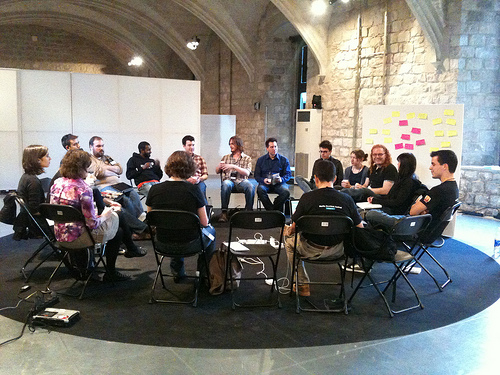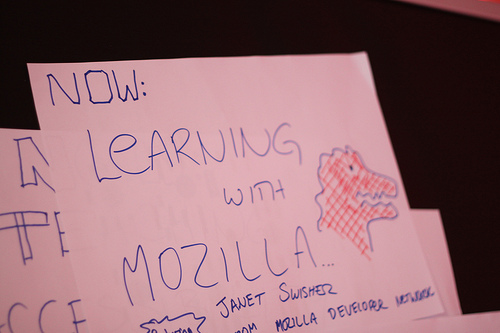User:Jswisher/Drumbeat Festival notes
Notes from Mozilla Drumbeat Festival
Jswisher 14:46, 15 November 2010 (PST)
My purpose in attending the Drumbeat Festival (DF) was to connect with others interested in web developer and education, and to look for ways of improving MDN content to help web developers.
The original concept of having me attend DF was to get feedback on the content that was written during the doc sprint in Paris in October 2010, from participants in the Webcraft Toolshed space/track. However, the program for the Webcraft Toolshed turned out not to involve actually trying to teach web development, but rather discuss ways to improve web developer education.
The Webcraft Toolshed (WT) program was organized by Pippa Buchanan, who is being paid by Mozilla Foundation to work on P2PU's School of Webcraft. I essentially put myself at her disposal to help with the program however she needed. Also involved were several people from the W3C Open Web Education Alliance (OWEA), including Chris Mills of Opera, Sandi Wassmer, and Henny Swan. Christian Heilman also attended large chunks of the WT sessions.
Day 0
The Festival started with a reception and Science Fair Wednesday evening. There was also a keynote by Joi Ito, which was heard by only a few people, thanks to the horrible acoustics in the space used for the reception at the Barcelona Museum of Contemporary Art (MACBA). I blogged a list of links I picked up from Science Fair presenters.
Day 1
In the first WT session following the opening keynotes, "Webcraft Ideas and Values", we discovered the limitations of the space that had been allocated to us (part of the main hall of the former Convent dels Angels, now owned by "Fostering Art and Design), as it was nearly impossible to conduct a group discussion that could be heard by all participants without being loud enough to also disturb the groups in the spaces on either side of us. We had to completely abandon the idea of a "human spectrogram" exercise (where participants stand in different locations based on their position on an issue), in favor of a tight group huddle. During this session, we also invited participants to write their goals for attending on sticky notes that we posted in the space.
The second session was on "The State of Web Education", and took the form of a "speed geek", where attendees rotate in small groups through multiple presenters (like speed dating), every 20 minutes. In this case, we presented multiple perspectives on web developer education. Sandi Wassmer represented employers and clients; Chris Mills was the web education activist; Anna Debenham was the disgruntled student; and Pippa and I represented the Mozilla approach to a solution. This disadvantage of this format was that I didn't get hear the other perspectives. However, Anna did give one of the evening keynotes, which was widely acclaimed as one of the highlights of the festival.
The third session the most valuable to me, in terms of getting input for MDN. "Shape the Webcraft Skills Map" was a brainstorming session to map the skills needed by web developers. Our starting point was a map of web skills originally created by Chris Blizzard. However, the break-out groups quickly turned over the A3 sheets that Pippa had printed the map on, and wrote on the back instead.
I took photos of the resulting notes and transcribed them into the session's etherpad.
The session on "Create P2PU Webcraft Courses" did not result in any new courses, but did introduce a group of attendees (including me) to a better understanding of how P2PU courses are organized and run.
In the session on "Teaching Accessibility", I was in the break-out group with Sandi Wassmer and others on transferring accessibility skills and knowledge into the workplace. We identified several issues, common roadblocks, and ways of addressing them. One of the biggest issues is transfer of responsibility -- how does the employee convince the employer to take responsibility for accessibility of the corporate site? The threat of legal liability is strong stick, but we tried to find "carrot" strategies as well. Accessibility is good for PR and for brand consistency across platforms, including mobile. Showing what a site looks like on a phone can also help make an analogy for the experience of people with impairments.
Day 2
Friday began with a plenary session consisting a round of lightning reports from the various spaces. Christian Heilman and Chris Mills reported for the Webcraft Toolshed. Chris H said, among other things, that "we accomplished more in 5 minutes of brainstorming about accessibility than I've seen in 8 years of going to conferences." He also exhorted attendees to come to the "School of Webcraft and Wizardry", with Chris M as Hagrid and himself as Ron Weasley.
The first session of the day was "Learning with Mozilla", in which I gave a whirlwind tour of the open standards resources on MDN, with a plug for PromoteJS. My original idea for break-out groups for this session was to ask what resources might be needed for P2PU courses on HTML, CSS, and JavaScript. That plan was quickly tossed, based on attendee introductions and interests. Instead, Pippa led a group on meeting needs of journalists to understand technology, Chris H led one on how to write a good tutorial, another group talked about using JavaScript with SVG, and I led one for "people who want to talk to Janet about MDN". The etherpad from the session contains the notes that one participant took.
One of the people in my breakout group was Colin Clark from the Inclusive Design Research Centre at Ontario College of Art and Design. They have a wiki of information related to WAI-ARIA, at http://codetalks.org which he suggested moving into MDN to give it a wider audience. We are now discussing that possibility via e-mail.
Another suggestion that came up in my breakout group (unfortunately, I didn't catch the suggestor's name) was to have a site that presents all the "best" content on web standards through a single interface; that is, not try to collect it all onto one site, but skin it so it looks all the same to the user. I have a feeling that content owners wouldn't be too pleased about this, but it's an intriguing idea from the user perspective.
The other session I attended on Friday was "Remixing the WaSP InterAct Curriculum", because I wanted to learn more about the WaSP InterAct curriculum. The main thing that I learned from this session is that planning a course from remixed materials is very much like planning a course from scratch, except that some stuff is already written. The materials in the curriculum appear good, but the site does not technically support remixing; that would need to be done manually by the instructor.
The remainder of Friday, I spent helping out with the FLOSS Manuals booki-mobile, which made its maiden voyage to the Drumbeat Festival. (I've been involved with FLOSS Manuals for a couple of years now.) All of the equipment was newly purchased, so the practical process of making books hadn't quite been worked out yet. You'd think that booklet printing A5 pages 2-up on A4 paper would be a no-brainer, but it turned out to be a PITA.
Outcomes
The two most tangible take-aways from Drumbeat Festival, for me, are:
- The map of web developer skills (it's not just about the technical stuff!) to help guide content planning for MDN.
- The contact with Colin Clark about possibly transferring the codetalks.org accessibility content to MDN.
The intangible take-aways are the contacts with all the people I met during the Festival, including Chris Mills of Opera, the OWEA folks, and many others. (I haven't mentioned other experiences like the conversation in the absinthe bar until 2 in the morning, because they weren't directly work-related, but they were personally valuable to me.)

